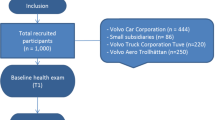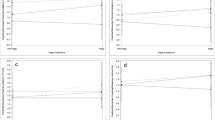Abstract
We used 2 different strategies to examine the relation between anger expression and lipid concentrations in 116 middle-aged men. Using the common analytic method used in the literature, the group-crossing approach, we examined whether Anger-In, Anger-Out, and their interaction were related to lipids. Regression analyses revealed that Anger-In and Anger-Out were marginally related to total cholesterol. These associations disappeared after controlling for hostility, anger, and anxiety. Using a new intraindividual-difference approach, we determined individuals’ relative dominance of Anger-In and Anger-Out and examined linear and quadratic associations with lipids. Regression analyses revealed the quadratic was related to both total cholesterol and low-density lipoprotein-cholesterol (LDL-c), indicating that individuals who almost always express their anger or almost never express their anger had both elevated total cholesterol and LDL-c. The curvilinear association with total cholesterol persisted even after controlling for hostility, anger, and anxiety.
Similar content being viewed by others
References
Barefoot, J. C., Dahlstrom, W. G., & Williams, R. B. J. (1983). Hostility, CHD incidence, and total mortality: A 25-year follow-up study of 255 physicians.Psychosomatic Medicine.45, 59–63.
Barefoot, J. C., Dodge, K. A., Peterson, B. L., Dahlstrom, W. G., & Williams, R. B. J. (1989). The Cook-Medley Hostility Scale: Item content and ability to predict survival.Psychosomatic Medicine.51, 46–57.
Blumenthal, J. A., Barefoot, J., Burg, M. M., & Williams, R. B. J. (1987). Psychological correlates of hostility among patients undergoing coronary angiography.British Journal of Medical Psychology.60, 349–355.
Buccolo, G., & David, H. (1973). Quantitative determination of serum triglycerides by the use of enzymes.Clinical Chemistry.19, 476–482.
Buss, A. H., & Durkee, A. (1957). An inventory for assessing different kinds of hostility.Journal of Consulting Psychology, 21, 343–349.
Cleveland, S. E., & Johnson, D. L. (1962). Personality patterns in young males with coronary disease.Psychosomatic Medicine, 24, 600–610.
Cook, W. W., & Medley, D. M. (1954). Proposed hostility and pharisaic-virtue scales for the MMPI.Journal of Applied Psychology.38, 414–418.
Costa, P. T. J., Zonderman, A. B., McCrae, R. R., & Williams, R. B. J. (1986). Cynicism and paranoid alienation in the Cook and Medley Ho Scale.Psychosomatic Medicine, 48, 283–285.
Dembroski, T. M., & Costa, P., Jr. (1987). Coronary prone behavior Components of the Type A pattern and hostility.Journal of Personality, 55, 211–235.
Dembroski, T. M., MacDougall, J. M., Williams, R. B., Haney, T. L., & Blumenthal, J. A. (1985). Components of Type A, hostility, and anger-in: Relationship to angiographic findings.Psychosomatic Medicine, 47, 219–233.
Dujovne, V. F., & Houston, B. K. (1991). Hostility-related variables and plasma lipid levels.Journal of Behavioral Medicine, 14, 555–565.
Engebretson, T. O., Matthews, K. A., & Scheier, M. F. (1989). Relations between anger expression and cardiovascular reactivity: Reconciling inconsistent findings through a matching hypothesis.Journal of Personality and Social Psychology, 57, 513–521.
Friedewald, W. T., Levy, R. I., & Fredrickson, D. S. (1972). Estimation of low-density lipoprotein cholesterol in plasma, without use of the preparative ultracentrifuge.Clinical Chemistry, 23, 499–502.
Funkenstein, D. H., King, S. H., & Drolette, M. (1954). The direction of anger during a laboratory stress-inducing situation.Psychosomatic Medicine, 16, 404–413.
Gidez, L. I., Miller, G. I., Burstein, M., Slagle, S., & Eder, H. A. (1982). Separation and quantification of subclasses of HDL by a simple precipitation procedure.Journal of Lipid Research.23, 1206–1223.
Goldstein, H. S., Edelberg, R., Meier, C. F., & Davis, L. (1988). Relationship of resting blood pressure and heart rate to experienced anger and expressed anger.Psychosomatic Medicine.50, 321–329.
Harburg, E., Erfurt, J. C., Hauenstcin, L. S., Chape, C. Schull, W. J.. & Schork, M. A. (1973). Socio-ecological stress, suppressed hostility, skin color, and black-white male blood pressure: Detroit.Psychosomatic Medicine, 35, 276–296.
Haynes, S. G., & Feinleib, M. (1980). Women, work and coronary heart disease: Prospective findings from the Framingham Heart Study.American Journal of Public Health, 70, 133–141.
Haynes, S. G., Feinleib, M., & Kannel, W. B. (1980). The relationship of psychosocial factors to coronary heart disease in the Framingham study. III. Eight-year incidence of coronary heart disease.American Journal of Epidemiology, 111, 37–58.
Haynes, S. G., Levine, S., Scotch, N., Feinleib, M., & Kannel, W. B. (1978). The relationship of psychosocial factors to coronary heart disease in the Framingham study. I. Methods and risk factors.American Journal of Epidemiology, 107, 362–383.
Jenkins, C. D. (1976). Recent evidence supporting psychological and social risk factors for coronary disease (First of two parts).The New England Journal of Medicine, 294, 987–994.
Johnson, E. H., Schork, N. J., & Spielberger, C. D. (1987). Emotional and familial determinants of elevated blood pressure in black and white adolescent females.Journal of Psychosomatic Research, 31, 731–741.
Johnson, E. H., Spielberger, C. D., Worden, T. J., & Jacobs, G. A. (1987). Emotional and familial determinants of elevated blood pressure in black and white adolescent males.Journal of Psychosomatic Research, 31, 287–300.
MacDougall, J. M., Dembroski, T. M., Dimsdale, J. E. & Hackett, T. P. (1985). Components of Type A. hostility, and anger-in. Further relationships to angiographic findings.Health Psychology.4. 137–152.
Matthews, K. A. (1988). Coronary heart disease and Type A behaviors: Update on and alternative to the Booth-Kewley and Friedman (1987) quantitative review.Psychological Bulletin, 104, 373–380.
Matthews, K. A., Glass, D. C., Rosenman, R. H., & Bortner, R. W. (1977). Competitive drive, pattern A, and coronary heart disease: A further analysis of some data from the Western Collaborative Group Study.Journal of Chronic Diseases, 30, 489–498.
Mendes de Leon, C. F. (1992). Anger and impatience/irritability in patients of tow socioeconomic status with acute coronary heart disease.Journal of Behavioral Medicine, 15, 273–284.
Miller, C. K. (1965). Psychological correlates of coronary artery disease.Psychosomatic Medicine, 27, 257–265.
Oken, D. (1960). An experimental study of supressed anger and blood pressure.Archives of General Psychiatry, 2, 441–456.
Patterson, G. R. (1985). A microsocial analysis of anger and irritable behavior. In M. A. Chesney & R. H. Rosenman (Eds.).Anger and hostility in cardiovascular and behavioral disorders (pp. 83–100). New York: McGraw-Hill.
Russek, L. G., King, S. H., Russek, S. J., & Russek, H. I. (1990). The Harvard mastery of stress study 35-year follow-up: Prognostic significance of patterns of psychophysiological arousal and adaptation.Psychosomatic Medicine, 52, 271–285.
Scherwitz, L. W., Perkins, L. L., Chesney, M. A., Hughes, G. H., Sidney, S., & Manolio, T. A. (1992). Hostility and health behaviors in young adults: The CARDIA study.American Journal of Epidemiology, 136, 136–145.
Shekelle, R. B., Gale, M., Ostfeld, A. M., & Paul, O. (1983). Hostility, risk of coronary heart disease, and mortality.Psychosomatic Medicine, 45, 109–114.
Siegel, J. M. (1985). The measurement of anger as a multidimensional construct. In M. Chesney & R. Rosenman (Eds.),Anger and hostility in cardiovascular and behavioral disorders (pp. 59–82). New York: McGraw-Hill.
Siegler, I. C., Peterson, B. L., Barefoot, J. C., & Williams, R. B. (1992). Hostility during late adolescence predicts coronary risk factors at midlifeAmerican Journal of Eptdeminlogy.136, 146–154.
Siegman, A. W., Dembroski, T. M., & Ringel, N. (1987). Components of hostility and the severity of coronary artery disease.Psychosomatic Medicine.49, 127–135.
Siegman, A. W., Feldstein, S., Tommaso, C. T., Ringel, N., & Lating, I. (1987). Expressive vocal behavior and the severity of coronary artery disease.Psychosomatic Medicine.49, 545–561.
Smith, T. W., & Frohm, K. D. (1985). What’s so unhealthy about hostility? Construct validity and psychosocial correlates of the Cook and Medley Ho scale.Health Psychology, 4, 503–520.
Smith, T. W., Sanders, J. D., & Alexander, J. F. (1990). What does the Cook and Medley hostility scale measure? Affect, behavior, and attributions in the marital context.Journal of Personality and Social Psychology.58, 699–708.
Spielberger, C. D., Gorsuch, R. L., & Lushene, R. E. (1970).Manual for the Slate-Trail Anxiety Inventory, Palo Alto, CA: Consulting Psychologist Press.
Spielberger, C. D., Jacobs, G. A., Russell, S. F., & Crane, R. J. (1983). Assessment of anger: The State-Trait Anger Scale. In J. Butcher & C. D. Spielberger (Eds.),Advances in personality assessment (pp. 161–189). Hillsdale, NJ: Lawrence Erlbaum Associates, Inc.
Spielberger, C. D., Johnson, E. H., Russell, S. F., Crane, R. J., Jacobs, G. A., & Worden, T. J. (1985). The experience and expression of anger. Construction and validation of an anger expression scale. In M. Chesney & R. Rosenman (Eds.),Anger and hostility in cardiovascular and behavioral disorders (pp. 5–30). New York: McGraw-Hill.
Spielberger, C. D., Krasner, S. S., & Solomon, E. P. (1988). The experience, expression, and control of anger. In M. P. Janlsse (Ed.),Individual differences, stress, and health psychology (pp. 89–108). New York: Springer-Veriag.
Theorell, T., Lind, E., & Floderus, G. (1975). The relationship of disturbing life changes and emotions to the early development of myocardial infarction and other serious illnesses.International Journal of Epidemiology, 4, 281.
Waldstein, S. R., Polefrone, J. M., Bachen, E. A., Muldoon, M. F., Kaplan, J. R., & Manuck, S. B. (1993). Relationship of cardiovascular reactivity and anger expression to serum lipid concentrations in healthy young men.Journal of Psychosomatic Research.37, 249–256.
Williams, R. B. J., Barefoot, J. C., & Shekelle, R. B. (1985). The health consequences of hostility. In M. Chesnev & R. Rosenman (Eds.),Anger and hostility in cardiovascular and behavioral disorders (pp. 173–185). New York: McGraw-Hill.
Author information
Authors and Affiliations
Additional information
This study was supported in part by National Heart, Lung, and Blood Institute Grants HL48363 and HL44847.
We acknowledge the expert lipid analyses provided by Linda Bausserman and her staff. We are also grateful for the valuable assistance of Lisa Kopel and Tracey Aiello, and we thank all of the participants of the Healthy Pilot Project.
Portions of these data were presented at the meeting of the Society of Behavioral Medicine, 1994.
Rights and permissions
About this article
Cite this article
Engebretson, T.O., Stoney, C.M. Anger expression and lipid concentrations. Int. J. Behav. Med. 2, 281–298 (1995). https://doi.org/10.1207/s15327558ijbm0204_1
Issue Date:
DOI: https://doi.org/10.1207/s15327558ijbm0204_1




